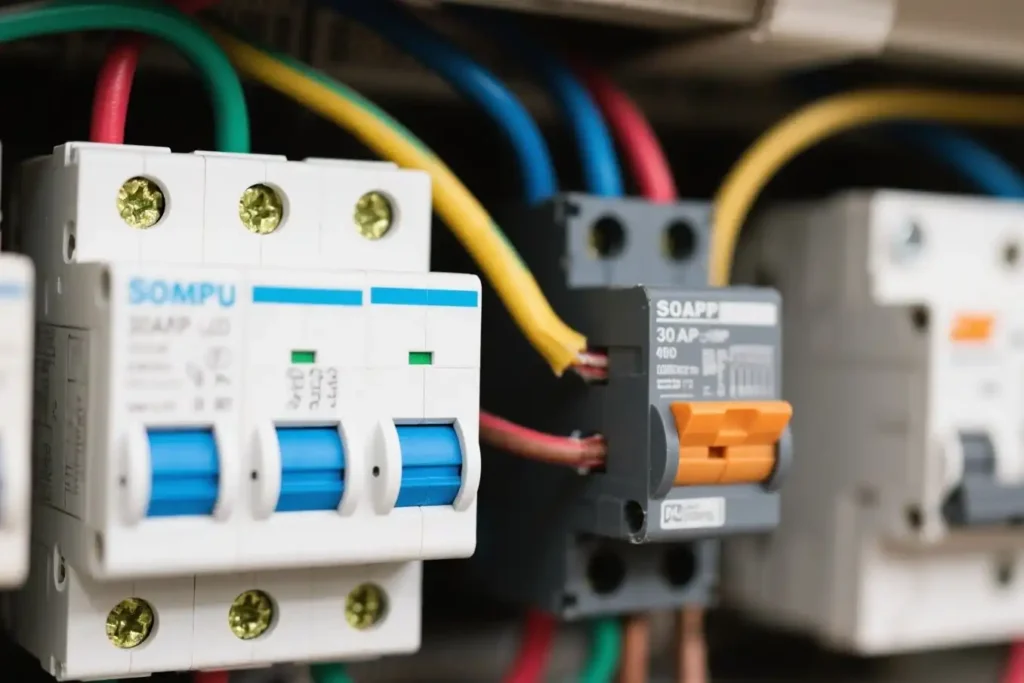Use 10 AWG copper wire for a 30 ampere circuit breaker. This wire size is safe and follows the National Electrical Code. It helps stop the wire from getting too hot. The table below gives important facts:
| Parameter | Value / Description |
|---|---|
| Wire Gauge | 10 AWG copper wire |
| Ampacity Rating (NEC standard) | 30 amps |
| Voltage Compatibility | 120V and 240V circuits |
| Maximum Length (3% drop) | ~100 feet |
You might need 8 AWG wire if the wire is very long. You can also use aluminum wire to keep your system safe.
Key Takeaways
- Use 10 AWG copper wire for a 30 ampere circuit breaker. This keeps things safe and follows electrical codes. – Pick 8 AWG wire for long runs over 100 feet. Use it also if you use aluminum wire. This helps stop voltage drop and overheating. – Always match the wire size to the circuit breaker’s amp rating. This helps stop fire risks from wires getting too hot. – Think about things like heat and wire bundling. These can lower wire capacity and may need thicker wire. – Follow local electrical codes and ask a licensed electrician if you are not sure. This keeps your home safe and helps you pass inspections.
30 Ampere Circuit Breaker Wire Size
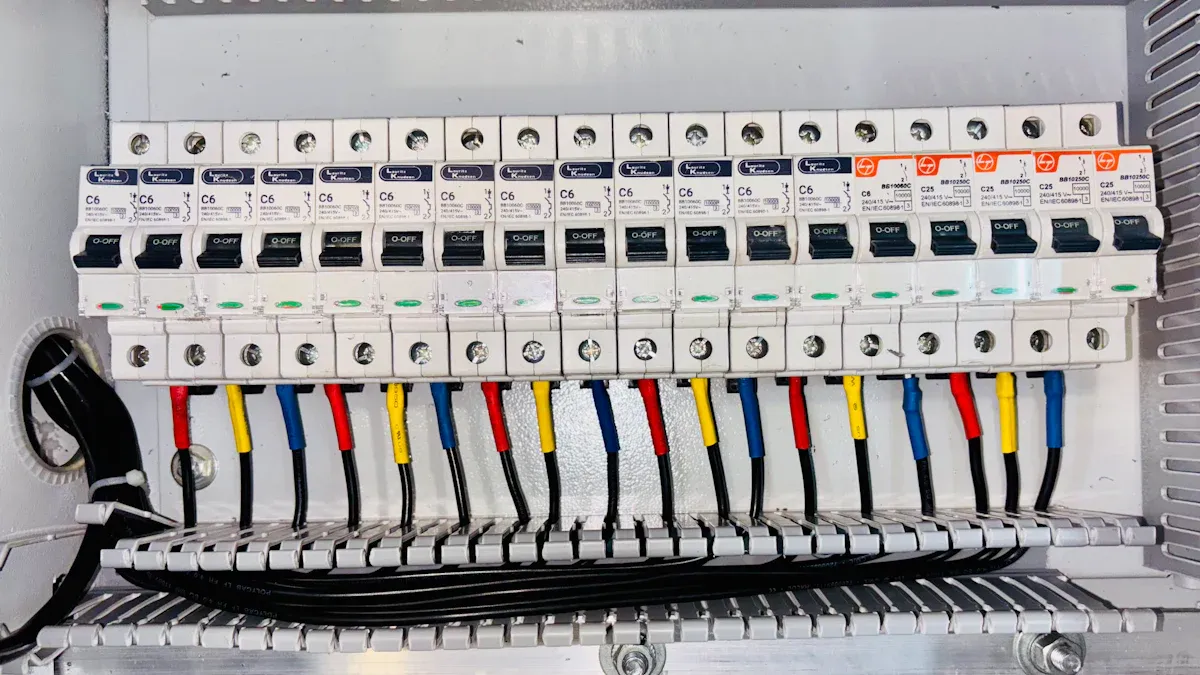
10 AWG Copper
If you need a wire for a 30 ampere circuit breaker, 10 AWG copper is the usual pick. This wire is about 2.588 millimeters thick. It can handle up to 30 amps safely. The wire will not get too hot or lose much voltage in normal use. Many homes use 10 AWG copper for big appliances like electric dryers or water heaters.
There are some good reasons to use 10 AWG copper wire:
- It has less resistance per foot than smaller wires, so less energy turns into heat.
- It bends easily, which helps when putting it in walls or pipes.
- It works well for both 120V and 240V circuits.
The National Electrical Code (NEC) Table 310.15(B)(16) says 10 AWG copper is okay for 30 amps. You also need to check the temperature rating of your breaker or panel. If your terminals are rated for 75°C, use the ampacity from the 75°C column. In most homes, 10 AWG copper wire will follow the code and keep things safe for a 30 ampere circuit breaker.
Tip: Always measure how far your wire needs to go. If your wire run is over 100 feet, you might need a thicker wire to stop voltage drop.
8 AWG for Long Runs or Aluminum
Sometimes, you need a bigger wire size. If your wire run is long, resistance goes up. This makes voltage drop more likely. Voltage drop should stay under 3% to keep things working right. For long runs, use 8 AWG wire instead of 10 AWG. This thicker wire has less resistance and keeps voltage drop low.
Aluminum wire is another choice, but it has more resistance than copper. To carry the same current, you need a bigger wire. For a 30 ampere circuit breaker, use at least 8 AWG aluminum wire. This stops the wire from getting too hot and meets code rules.
Here is a table to help you compare:
| Wire Gauge | Copper Ampacity (A) | Aluminum Ampacity (A) | Voltage Drop (V/100 ft @ 20A) |
|---|---|---|---|
| 8 AWG | 50 | 40 | 0.13 |
You can see that 8 AWG copper wire can handle up to 50 amps. 8 AWG aluminum can only handle 40 amps. The voltage drop for 8 AWG copper is just 0.13 volts per 100 feet at a 20 amp load. This shows why you need a thicker wire for long runs or if you use aluminum.
The temperature around the wire and how you install it also matter. Hotter places or putting wires together can lower how much current the wire can carry. Here are some common ampacity reductions:
| Temperature (°C) | Reduction (%) |
|---|---|
| 25 | 0 |
| 30 | 10 |
| 35 | 20 |
| 40 | 30 |
| 45 | 40 |
| Method | Reduction (%) |
|---|---|
| Open Air | 0 |
| Conduit/Raceway | 15-20 |
| Bundled Conductors | 30-40 |
| Underground (soil) | 10-15 |
| Underground (thermal backfill) | 5-10 |
If you put wire in a hot attic or bundle wires together, you may need 8 AWG even for short runs. This keeps your system safe and stops overheating.
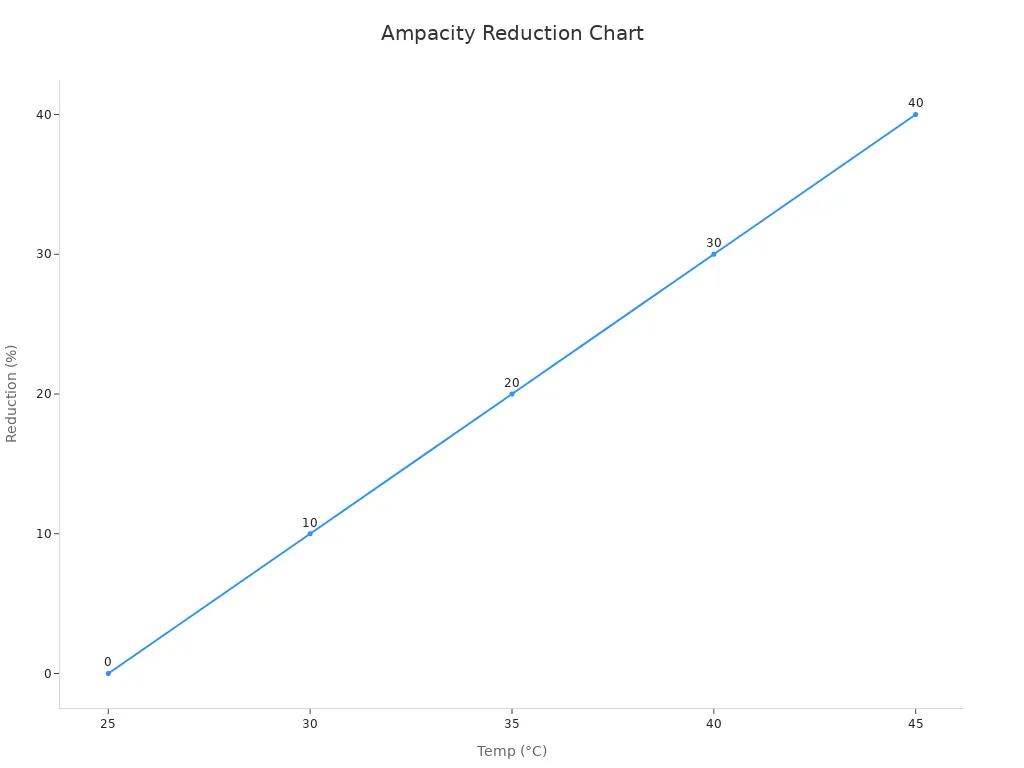
Note: Always follow local codes and what the manufacturer says. If you are not sure, pick a thicker wire for your 30 ampere circuit breaker, especially for long runs or if you use aluminum wire.
Why Size Matters
Ampacity
You must pick the right wire size because of ampacity. Ampacity is how much current a wire can safely carry. If the wire is too small, it cannot handle 30 amps. This can make the wire get too hot and hurt the insulation.
The American Wire Gauge (AWG) system helps you choose the right wire. For a 30 ampere circuit breaker, 10 AWG wire is the usual choice. The National Electrical Code gives ampacity ratings for each wire size. These ratings depend on the wire’s material, insulation, and how you put in the wire.
| Amp Rating (Amps) | Recommended Wire Gauge |
|---|---|
| 10 | 16-gauge |
| 15 | 14-gauge |
| 20 | 12-gauge |
| 30 | 10-gauge |
If you put wires together or run them in hot places, you must lower the ampacity. For example, a 10 AWG wire with four wires together only carries 80% of its normal ampacity.

Safety Risks
Using the wrong wire size can be dangerous. If the wire is too small, it can get very hot. This heat can melt the insulation and start a fire. Your appliances can also get damaged, and your system will not be safe.
Engineers use safety factors to help stop these problems. They add extra space between the wire’s ampacity and the real current. This helps with heat, old wires, and sudden high current. For example:
- High heat, bundling, and long wires all lower safe ampacity.
- In important systems, engineers use a wire that can handle 150% of the needed current.
- Tests like thermal imaging and current checks help make sure the wire stays safe.
Never use a wire smaller than what the code says. Even if it works at first, it could fail later and put your home in danger.
Other Factors
Distance
How far the wire goes is very important. Longer wires have more resistance. This makes voltage drop happen. Voltage drop means less power gets to your device. If voltage drop is too high, things may not work right. Sometimes, equipment can even get damaged. Experts say voltage drop should stay under 5%. This keeps things safe and working well. If your wire is over 100 feet, use a thicker wire. 8 AWG is better than 10 AWG for long runs. Thicker wire keeps voltage drop low. It also helps your circuit stay safe. Studies show long wires lose more voltage. They also slow down how fast a breaker trips. Always check your wire length. Use a bigger wire if you need to.
Wire Material
The kind of wire you pick matters too. Copper wire carries more current than aluminum wire. Copper has better conductivity and handles heat better. Aluminum wire is lighter and costs less. But it must be about 56% bigger to carry the same current. If you use aluminum, pick a thicker gauge. This matches the ampacity of copper. Copper does not expand much when hot. This keeps connections tight and safe. Aluminum wires need special connectors. They also need special ways to install them. This stops problems like oxidation and loose joints.
| Property | Copper | Aluminum |
|---|---|---|
| Conductivity | Higher | Lower |
| Required Size | Smaller | Larger |
| Weight | Heavier | Lighter |
| Cost | Higher | Lower |
| Expansion with Heat | Less | More |
Installation Conditions
Where you put the wire changes what size you need. Wires in hot places get much warmer. Heat lowers how much current a wire can carry. Wires in conduit or bundles cannot cool off well. The National Electrical Code has rules for this. You must adjust wire size for heat and bundles. For example, conduit close to a rooftop gets very hot. You must use a big correction factor for heat. This can cut safe ampacity by more than half. Always check your wire’s temperature rating. Follow local codes to stay safe.
Tip: Never use 12 AWG wire for a 30 amp circuit. It cannot handle the current and may get too hot. Use 8 AWG for long runs, aluminum, or hot places.
Ampacity Chart
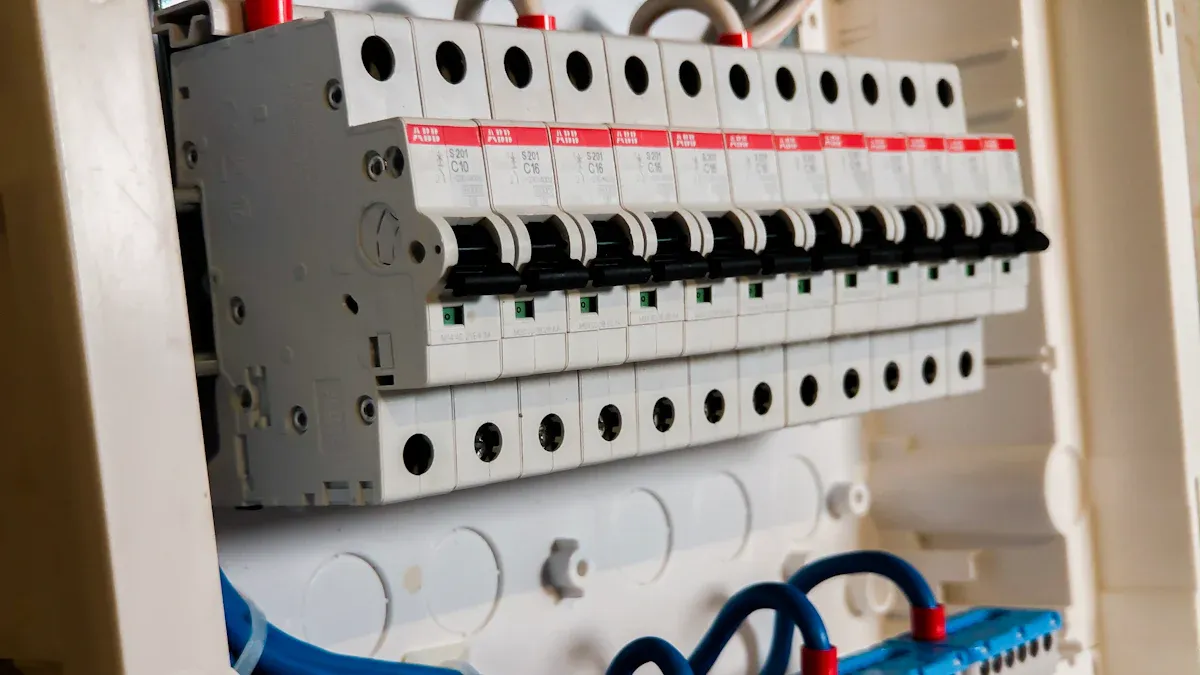
Choosing the right wire size for your circuit is easier when you have a clear chart. You can use ampacity charts to see what each wire gauge can handle. These charts show the maximum current (amps) that different wire sizes can safely carry. You can also see which wire is best for copper or aluminum.
Here is a quick reference table for common wire gauges and their amp ratings:
| Wire Gauge (AWG) | Copper Ampacity (A) | Aluminum or Copper-Clad Aluminum Ampacity (A) |
|---|---|---|
| 14 | 15 – 25 | N/A |
| 12 | 20 – 30 | 15 – 25 |
| 10 | 30 – 40 | 25 – 35 |
| 8 | 40 – 55 | 35 – 45 |
| 6 | 55 – 75 | 40 – 55 |
| 4 | 70 – 95 | 55 – 75 |
| 3 | 85 – 115 | 65 – 85 |
| 2 | 95 – 130 | 75 – 100 |
| 1 | 110 – 145 | 85 – 115 |
| 1/0 | 125 – 170 | 100 – 135 |
| 2/0 | 145 – 195 | 115 – 150 |
| 3/0 | 165 – 225 | 130 – 175 |
| 4/0 | 195 – 260 | 150 – 205 |
Ampacity ranges depend on insulation type and temperature rating. Always check the National Electrical Code (NEC) Table 310.15(B)(16) for exact values.
You can also look at a chart that shows the typical amp rating for each wire size and where you might use it:
| Wire Gauge (AWG) | Typical Rated Ampacity (A) | Common Applications |
|---|---|---|
| 10 | 30 | Clothes dryers, water heaters |
| 12 | 20 | Kitchen, bathroom, outdoor outlets |
| 14 | 15 | Lighting circuits, lamps |
| 6 | 55 | Electric ranges, cooktops |
| 4 | 70 | Large heaters, electric furnaces |
| 2 | 95 | Large water heater elements |
You can see how the amp rating goes up as the wire gets thicker. For a 30 amp circuit breaker, you should use 10 AWG copper wire. If you use aluminum, you need a thicker wire, like 8 AWG.
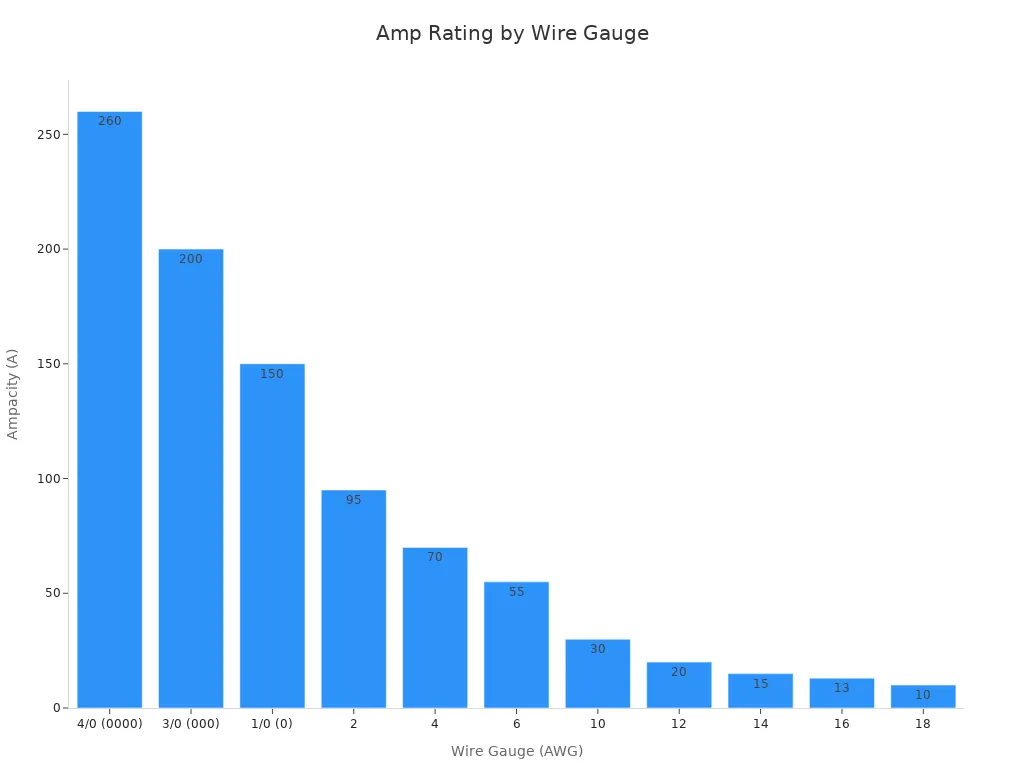
Tip: Always match the wire size to the amp rating of your breaker. Using the right size keeps your home safe and your devices working well.
Risks of Wrong Size
Overheating
Using the wrong wire size can be dangerous for your home. Wires that are too small can get very hot. This heat can melt the insulation and cause a fire. You might not see the problem until it is too late. Many reports show that fires often start because wires are not the right size for the job.
- Wires that are too small for the current can get hot and cause fires.
- The wire size must match the electrical load to stay safe.
- Using strong extension cords and the right circuit breakers helps lower risks.
- Checking for fire risks often can help find wiring problems before they get worse.
Always use the right wire size for your 30 ampere circuit breaker. The correct wire size keeps things safe and helps stop electrical fires. Circuit breakers and not overloading outlets are also important for safety.
🔥 Tip: If you see warm outlets, lights that flicker, or smell something burning, turn off the power and check your wires. These signs can mean your wires are getting too hot.
Code Issues
Electrical codes are rules that help keep you safe. These rules say what wire size to use, how to ground wires, and how far wires should be from other things. If you do not follow these rules, you could have safety problems, break the law, or fail your inspection.
- Electrical codes tell you the smallest wire size, how to ground, and how far wires should be from other things to keep you safe.
- Not following these rules can make things unsafe, break the law, and make inspections hard to pass.
- Inspections mean you set up a time with the local office, get your work ready, and have a trained inspector check everything.
- Inspectors look at how you put in the wires, if you grounded them right, if you used the right size parts, and if you followed safety steps.
- After the inspection, you get a report that tells you what is right and what needs fixing.
- If there are problems, you must fix them and have another inspection.
- Passing the next inspection shows you followed the rules and your wiring is safe.
If you use the wrong wire size for a 30 ampere circuit breaker, you might not pass your inspection. You will have to fix the problem and get checked again. Following the code from the start saves time and keeps your home safe.
You should use 10 AWG copper wire for a 30 ampere circuit breaker in most cases. If your wire run is longer than 100 feet or you use aluminum wire, you may need to upsize to 8 AWG. Always follow local electrical codes and check with a qualified electrician for special situations.
- 10 AWG copper works for both 120V and 240V circuits.
- Upsizing to 8 AWG helps prevent voltage drop and overheating on long runs.
Choosing the right wire size keeps your system safe and reliable.
FAQ
What happens if you use 12 AWG wire on a 30 amp breaker?
You risk overheating the wire. 12 AWG wire cannot safely carry 30 amps. This can cause the insulation to melt and may start a fire. Always use at least 10 AWG copper wire for a 30 amp breaker.
What wire size do you need for a 30 amp breaker if the run is over 100 feet?
You should use 8 AWG copper wire for long runs over 100 feet. This thicker wire helps prevent voltage drop and keeps your devices working safely.
What is the difference between copper and aluminum wire for a 30 amp circuit?
Copper wire carries more current and resists heat better. Aluminum wire needs to be thicker to carry the same current. For a 30 amp breaker, use 10 AWG copper or 8 AWG aluminum.
What appliances use a 30 amp circuit?
You often find 30 amp circuits used for electric dryers, water heaters, and some RV hookups. These appliances need more power than standard outlets.
What should you do if you are unsure about wire size?
Tip: Always ask a licensed electrician if you feel unsure. They know the codes and can help you choose the safest wire size for your project.
The following information may be of interest to you
What size of wire is suitable for a 30 ampere circuit breaker
How to choose wires for your 220V 15 ampere circuit breaker
Comparing Single Phase Voltage and Three Phase Voltage
Why a bad circuit breaker can cause low voltage
Solar grid connected inverter with intelligent monitoring

